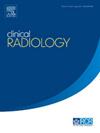Dual-layer spectral computed tomography (CT) parameters for identifying severe aortic regurgitation in aortic valve disease patients
IF 1.9
3区 医学
Q2 RADIOLOGY, NUCLEAR MEDICINE & MEDICAL IMAGING
引用次数: 0
Abstract
AIM
To investigate the diagnostic potential of dual-layer computed tomography (DLCT) in detecting the severe aortic regurgitation (sAR) among patients with aortic valve disease (AVD).
MATERIALS AND METHODS
This retrospective study included 53 AVD patients who underwent both transthoracic echocardiography (TTE) and DLCT within one week. Patients were categorised into sAR (n = 16) and nonsevere AR (non-sAR, n = 37) groups based on TTE findings. DLCT parameters, including aortic annulus dimensions (max/min diameter, circumference, area), sinus of Valsalva (SOV) diameter, ascending aorta diameter (AoD), and myocardial extracellular volume (ECV) fraction, were analysed. Logistic regression analysis was employed to identify risk factors for sAR in patients with AVD, and the diagnostic performance of DLCT parameters was evaluated using receiver operating characteristic (ROC) curves.
RESULTS
Patients with sAR were significantly younger and had larger aortic valve parameters compared to the non-sAR group. Computed tomography-ECV (CT-ECV) was notably higher in the sAR group (33.19 ± 3.86% vs 29.05 ± 4.58%, P< 0.05). Logistic regression analysis identified CT-ECV and SOV diameter as independent predictors of sAR (CT-ECV: OR = 1.531, 95% CI: 1.133–2.070, P= 0.006; SOV diameter: OR= 1.198, 95% CI: 1.056–1.359, P= 0.005). Both parameters effectively distinguished sAR from non-sAR patients. Their combined model enhanced diagnostic performance (AUC = 0.867) and maintained excellent accuracy (AUC = 0.819) in the mild-moderate AR (mAR) subgroup.
CONCLUSION
DLCT-derived CT-ECV and aortic valve parameters effectively identify sAR in AVD patients. The combination of CT-ECV and SOV diameter offers the highest diagnostic accuracy, potentially improving AVD management.
双层频谱计算机断层扫描(CT)参数识别主动脉瓣疾病患者严重主动脉反流。
目的:探讨双层计算机断层扫描(dct)对主动脉瓣病变(AVD)患者重度主动脉瓣反流(sAR)的诊断价值。材料和方法:本回顾性研究包括53例AVD患者,他们在一周内接受了经胸超声心动图(TTE)和dct检查。根据TTE结果将患者分为sAR (n = 16)和非严重AR (non-sAR, n = 37)组。分析dct参数,包括主动脉环尺寸(最大/最小直径、周长、面积)、Valsalva窦(SOV)直径、升主动脉直径(AoD)、心肌细胞外体积(ECV)分数。采用Logistic回归分析确定AVD患者sAR的危险因素,并采用受试者工作特征(ROC)曲线评价dct参数的诊断效能。结果:与非sAR组相比,sAR患者明显更年轻,主动脉瓣参数更大。sAR组CT-ECV(33.19±3.86% vs 29.05±4.58%,P< 0.05)明显高于sAR组。Logistic回归分析发现,CT-ECV和SOV直径是sAR的独立预测因子(CT-ECV: OR= 1.531, 95% CI: 1.133-2.070, P= 0.006; SOV直径:OR= 1.198, 95% CI: 1.056-1.359, P= 0.005)。这两个参数都能有效区分sAR和非sAR患者。他们的联合模型提高了诊断性能(AUC = 0.867),并在轻中度AR (mAR)亚组中保持了良好的准确性(AUC = 0.819)。结论:dlct衍生的CT-ECV和主动脉瓣参数可有效识别AVD患者的sAR。CT-ECV和SOV直径的结合提供了最高的诊断准确性,有可能改善AVD的治疗。
本文章由计算机程序翻译,如有差异,请以英文原文为准。
求助全文
约1分钟内获得全文
求助全文
来源期刊

Clinical radiology
医学-核医学
CiteScore
4.70
自引率
3.80%
发文量
528
审稿时长
76 days
期刊介绍:
Clinical Radiology is published by Elsevier on behalf of The Royal College of Radiologists. Clinical Radiology is an International Journal bringing you original research, editorials and review articles on all aspects of diagnostic imaging, including:
• Computed tomography
• Magnetic resonance imaging
• Ultrasonography
• Digital radiology
• Interventional radiology
• Radiography
• Nuclear medicine
Papers on radiological protection, quality assurance, audit in radiology and matters relating to radiological training and education are also included. In addition, each issue contains correspondence, book reviews and notices of forthcoming events.
 求助内容:
求助内容: 应助结果提醒方式:
应助结果提醒方式:


